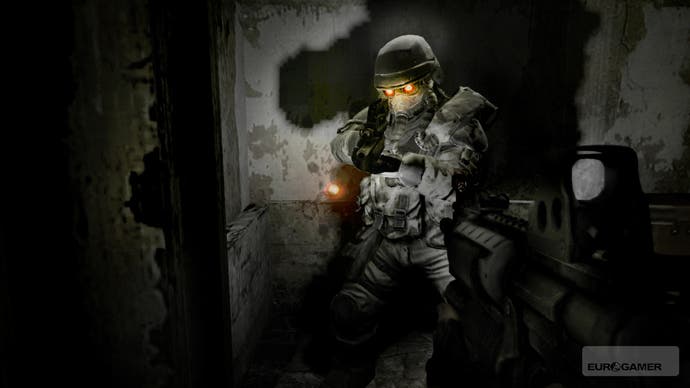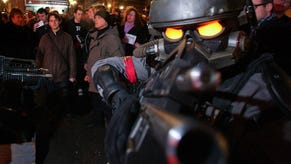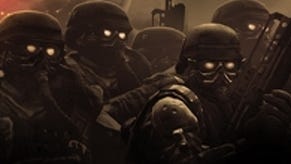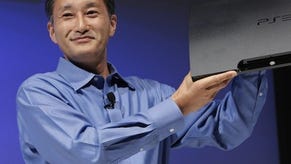Killzone 2
Quite what that screenshot was about...
Phil Harrison says Killzone 2 is important to Sony because the level of anticipation has been set so high. Picking through the wreckage of the first in-game screenshot, which popped up in a US newspaper just prior to E3, it's easier to read it the other way: Killzone 2 is important to Sony because the level of cynicism has been set so high. MotorStorm, another E3 2005 graduate, overcame the stigma by delivering on the concept rather than the graphics. Settling into a screening room beneath a Sushi bar on the streets of Santa Monica last night, we got our first chance to see whether Killzone 2 could hope to do likewise.
Like the E3 2005 trailer, it begins in crowded confines, aboard an "intruder" - the aerial equivalent of a D-day landing barge, apparently used for fast, rough deployment in the face of heavy resistance. Grey clouds dominate the background as you pull alongside another barge and exchange frightened comments and orders. Suddenly, a spark of lightning blasts the other barge and it violently disintegrates in a flash of red that's part explosion and maybe part blood haze. Perhaps we're imagining it. The lightning came from below. As the clouds part, your eyes zigzag the storm-ridden greys and browns of an industrial complex, part of a sprawl of dirty buildings, courtyards, ramps and walkways, peppered with explosions and bursting with violent noise, into which you're swooping as all around you cling on for dear life.
The intensity's apparent before you even land. When you do, the scattered wreckage of your shattered metal surroundings provides points of natural or at least coherent cover, as a rendezvous objective flashes across the top of the screen. Helghast are in a mixture of elevated positions around your squad, which is reinforcing friendly troops already deep in combat. The concentration of activity is instantly arresting and easy to mine for highlights. Shot in the neck, a Helghast trooper gropes his throat theatrically before trying to return his hands to his gun and taking more bullets in the chest and hips, twisting as each impact shatters his capacity to respond. Elsewhere a frag grenade lands in amongst his friends, and the explosion blows them to their knees and onto their faces. Herman Hulst, MD of Guerrilla, tells us afterwards that enemies react differently not just based on the game's interpretation of positional damage, but also the weapon used.

Despite the initial open setting, it's claustrophobic, and the demo spends more time in corridors and crossing walkways to clear Helghast positions. The palette, in keeping with Killzone 1, is intelligently narrow. The redness of the blood spurting from jugular veins and chest wounds is in stark contrast to the limited grey scale. When you walk past a body in a pool of blood, it jars. Meanwhile the sounds around you are being articulated with something called audio occlusion, Hulst says, which helps to put the noises you here into environmental context - with a grenade blast indoors quite different to one in the open. Probably the most striking thing, however, is that it's a good three or four minutes before we notice something that punctures the atmosphere: the slight tagging of a wall by an allied soldier as he turns a corner, as his character-model's reaction to the scenery overrides his animations.
None of this, you may notice, is to say that Killzone 2 today resembles the Killzone 2 "target footage" demonstrated in 2005. What we have instead is a clever assembly of complementary elements. The palette, sound and claustrophobic design give it intensity, while impressive use of depth-of-field, motion blurring, particles and other hazy effects contribute importantly. When you reload your gun, it's pulled right up in your face, but it's blurred through lack of concentration, while beyond the cartridge swap-over the battleground is crystal clear. Physics aren't over-played - the demo man stops to shoot a few tins, planks and a loud-speaker at one point, but mainly to illustrate that it's there. Killzone 2 clearly takes the view that "doing gravity properly" is important, but not defining.









